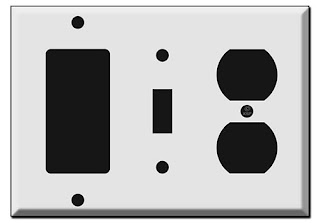If you have any switches or outlets in your home that don't have a cover plate - because you can't find one that fits - you're in the right place.
This post goes over how to create any configuration wall plate, without breaking the bank.
You may need a particular configuration that you can't find. Or, you may be able to find it, but not in the finish you desire.
The first question to ask is this:
Can you re-arrange the devices?
Your electrical devices are currently mounted into the box in a particular order.
But they don't have to stay in that order.
If you can find a cover that has the correct openings in a different sequence, unscrew one or two of your devices & swap them around.
This is the fastest and simplest way to get a plate in the correct configuration.
To be safe, always turn off power to the devices before tampering with them.
Shop combination covers here to find the plate you need or one that will work if you re-arrange your devices.
For example, if you have a duplex outlet among dimmers or switches and can't find the cover you need, update the duplex outlet to a block outlet.
Change duplex outlets to block outlets.
Older toggle switches can be updated to modern Decora rocker paddle switches, which are now a more common wall plate opening.
Change toggle switches to modern rockers.
Updating a device's style is another simple solution that will only take a few minutes.
Note: always cut the power to the switch or outlet at the circuit breaker before messing with it to avoid electric shock. Always hire an electrician if you don't feel comfortable handling electrical components yourself.
Finally, you can create a custom configuration with switch plate inserts.
Since the larger, rocker openings are so common and available in many finishes, converting them with inserts is a great way to get the custom plate you need.
Inserts typically fill rocker openings and have a cutout for a smaller device.
At Kyle Switch Plates, our most popular selling inserts are for toggle switches.
Toggle inserts sit under any wall plate's rocker opening to allow for a toggle light switch to go there instead.
For example, suppose you need this combo plate, but in a finish that's not manufactured, such as black:
Simply find a plate that has a rocker opening instead of toggle in the center, and add an insert in that spot:
Plate with rocker instead of toggle in center.
Toggle insert for rocker opening.
Inserts are easy to use and offer a great solution to creating your own custom wall plate.
Kyle Switch Plates carries a variety of switch plate inserts in white, brass, ivory, gray, silver, brown, bronze, black and more.
Use them to convert cover plate openings to blanks, toggles, cable/phone jacks and more.
Click to shop combination switch plates and inserts for converting switch plates.



































































